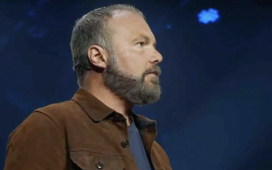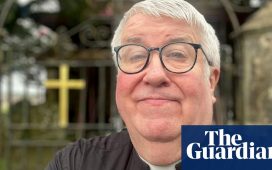For 150 years, in a small, tree-lined corner of a Buckinghamshire field, a large pile of stones lay overgrown and almost forgotten. A thriving local parish church for almost 800 years, the little building of St Mary’s near Stoke Mandeville had gradually fallen out of use and been abandoned. By 1866 its crumbling walls were judged to be dangerous and it was pulled down, its rubble left to the grass and weeds.
The site of Old St Mary’s church is no longer silent. The ruins sit on the route of what will – most people in Buckinghamshire now reluctantly concede – become the HS2 rail link, and like dozens of other landscape features along the line’s 150-mile length, they are busily being excavated ahead of the track’s construction. This week, HS2 archaeologists announced they had identified 3,000 burials in the churchyard that will be carefully exhumed and reburied elsewhere.
It is a lot of attention to give a small pile of tumbled stones but, says Rachel Wood, the lead archaeologist on site, St Mary’s offered a “unique opportunity” to excavate an entire medieval church and churchyard. “Most churches that you can think of – they are all still standing. Normally we don’t get an opportunity to excavate a building in this way and understand the changes and developments it went through.”

The remains date to the early years after the Norman invasion, around 1080. At the time, according to the Domesday Book, the village of Stoke (the Mandeville would come later) was home to 24 families, three enslaved people, enough woodland for 30 pigs, and a mill valued at 10 shillings.
The church was expanded through the medieval, Tudor and Victorian periods, and burials continued until the early 20th century. A number of their identities are known to local historians, in part through wills dating back to 1550; the archaeologists also plan to examine a proportion of the human remains to learn more about the community’s health over the centuries.
But the location of the church may also hint at other potential histories. Intriguingly, the old church is situated some distance from the village of Stoke Mandeville itself, surrounded by two streams. Wood’s team plan to look for evidence of any Anglo-Saxon structure under the Norman stonework, while a previously unknown Roman settlement has also been identified nearby.
“Obviously, we’re looking closely at the medieval part of the story. But what I find interesting is stitching it back into its longer history,” she says.
Streams, particularly where they meet, have frequently been venerated throughout history, “and so it is possible that this could have been a special place much longer than the medieval or Saxon periods. But we won’t know unless the evidence has survived.”
Peter Marsden, who is chair of the Buckinghamshire Archaeological Society (BAS) and has written a pamphlet on the history of St Mary’s, has said the church is of national importance due to the role it played in the period immediately before the Norman conquest. “But the thing is – in this part of Buckinghamshire, you can’t really put a trowel into the ground without finding something.”
That is scarcely an exaggeration: St Mary’s is about a mile from the spot where archaeologists last year discovered a large Neolithic wooden henge monument aligned to the winter solstice; an iron age potential murder victim and a Roman lead-lined grave were also found in the vicinity. The irony is that while all have been found as part of the HS2 development, all will in time be obliterated by it.

The BAS has highlighted concerns over the impact of the line on at least 10 historical sites in the county, but local opposition is not merely centred around archaeology. The campaign group Stop HS2 lists 34 local action groups in Buckinghamshire alone, and nearby Wendover has been the scene of encamped protesters trying to block the destruction of ancient woodland – after a lengthy battle, some of this was felled only in the last week.
Noise, pollution, environmental damage and the impact on house prices are also concerns, say local activists. “I don’t think I have met anybody who is delighted about the prospect of HS2,” says one.
Helen Wass, the head of heritage for HS2, said decisions over infrastructure projects of this kind were made by others, “but if a construction project is going ahead, then we [archaeologists] are going to make sure that the historic environment is excavated to the best of our abilities, that the information is shared, and that we can tell the stories of those people so that the people at St Mary’s can learn about their ancestors, and the general public can learn a little bit more about how we used to live and how we shaped our landscape.”





